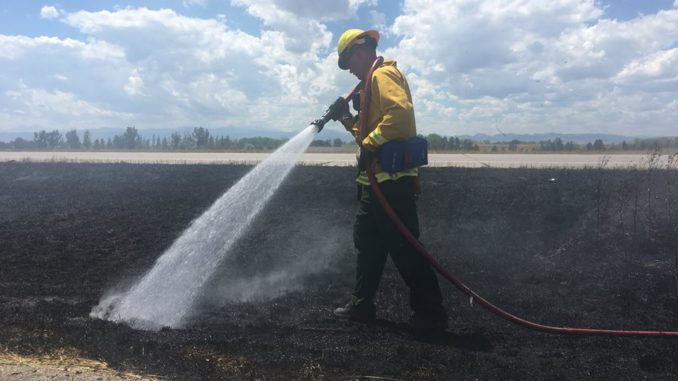
Marty Metzger
mmetzger@northfortynews.com
Rachael Gonzales, Communications Specialist for the Wellington Fire Protection District, is well aware of Northern Colorado’s high risk for wildfires. She adamantly stressed the need to stay informed and to devise/focus on a specific plan of action to assure your family and property’s safety.
First, know the difference between a Fire Weather Watch and Red Flag Warning. The former means the potential exists for dangerous conditions within the next 72 hours. A Red Flag Warning (which means danger now) is issued when wind gusts are in excess of 25 mph and the relative humidity is at 15 percent or less.
Knowing the answers to four simple questions will initiate your emergency plan.
How will I receive emergency alerts and warnings?
Larimer County has LETA911. Go to http://leta911.org for more information. Also check other online emergency information sources. Reverse 911 is also available. NOTE: Larimer County no longer implements any emergency sirens.
What is my evacuation route?
Be sure to have primary and secondary routes planned. If one is blocked, a backup is critical.
What is my family/household communication plan?
This should include cell phones and a pre-agreed meeting location, should family members become separated during an evacuation.
Do we have a 72-hour emergency preparedness kit?
Maintain this kit, which should include a flashlight, (working) batteries, cash, and first aid supplies.
Practice your plan and correct any issues before an actual disaster occurs.
Create and maintain a 30-foot area around your home free of any combustibles, such as wood piles, dried leaves, newspapers, brush, and other flammable materials. From 30 feet to 100 feet, reduce as much vegetation as possible, and prune the remainder. Create fuel breaks, such as driveways and gravel walkways.
Coordinate with neighbors to create spaces up to 200 feet around your home where vegetation is thinned and underbrush removed. Tall trees shouldn’t touch to create continuous canopies for flames. Regularly clean your roof and gutters. These simple steps can prevent your home from becoming fuel for fire.
Your home is not only a financial investment but also an emotional one. Specific items should be at your fingertips and ready to go in case an evacuation is necessary. These include important documents (such as driver’s license, Social Security information, etc.); photos; laptops and flash drives; medications for your family and pets; other important items specific to your lifestyle.
Always include pets and other animals in your planning and execution of emergency evacuations. Have dogs/cats trained to come when called, including free-ranging animals. In the case of large animals such as horses, be certain to have immediate access to enough trailers to accommodate them. Be sure your horses are properly trained to load. Keep flooring in good repair, hitches in working order, and tires and a spare properly inflated.
The time to prepare all this (or to desperately call around to neighbors and friends seeking more trailer space) isn’t as flames are racing through your pastures or lapping at your barns. Always be prepared to load and go at a moment’s notice.
Worst case scenario: if you are unable to evacuate them, turn horses and other animals loose. But be certain loose is truly loose, not loose within a fenced enclosure where they will still be trapped. Fire is a horse’s worst nightmare, and panic often drives them back into their place of safety: barns, sheds or corrals. Be sure they are unable to access these. It’s easier to search for them out in the open after a fire, flood or other emergency than to learn they perished in their stalls.
Gonzales recalled a particularly perilous day last year. March 4, 2017, was very windy, but no Red Flag Warning had been issued. A homeowner using a barbeque pit that he’d properly installed but hadn’t cleared of surrounding grasses resulted in a 320-acre wildfire.
The fire crew that handled that emergency were returning back to their station when they were dispatched to a second fire, this one started by a man using a welding torch alongside his home…in the high winds. A spark set off an ultimately 2200-acre grass fire.
Youngsters playing with matches or fireworks have been the cause of numerous incidents, sometimes with deadly consequences. Be sure to teach your children that flame isn’t a toy, nor is it an exciting experiment!
Visit https://www.ready.gov/wildfires and https://www.nfpa.org/Public-Education/By-topic/Wildfire for more tips on wildfire preparedness. Additional information specifically on mitigation and preparing your home can be found at www.firewise.org.
Gonzales encourages everyone to attend Wellington Fire Protection’s May 5 Wildfire Preparedness Day Open House at Station 2 in Waverly, where a wealth of information on wildfire preparedness will be available. The event will run from 11 a.m.-2 p.m.
Support Northern Colorado Journalism
Show your support for North Forty News by helping us produce more content. It's a kind and simple gesture that will help us continue to bring more content to you.
BONUS - Donors get a link in their receipt to sign up for our once-per-week instant text messaging alert. Get your e-copy of North Forty News the moment it is released!
Click to Donate